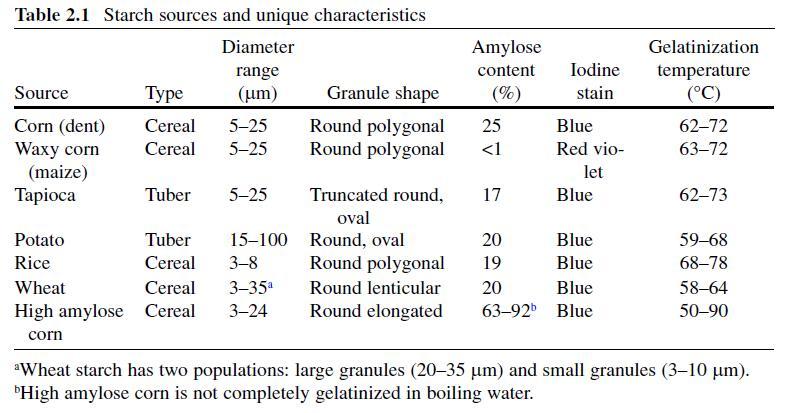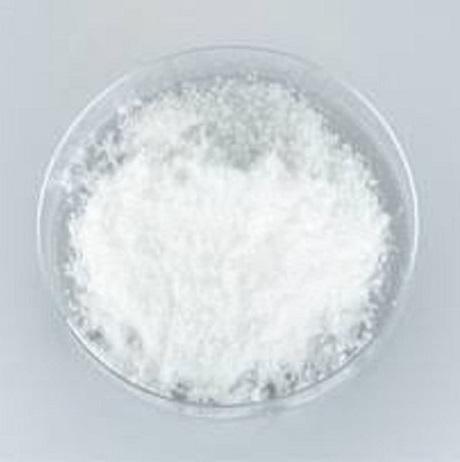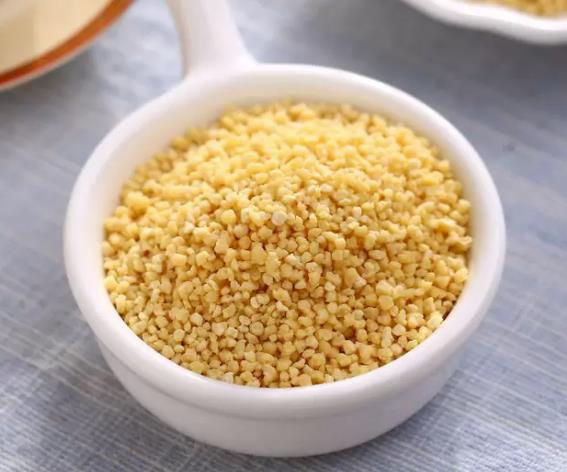Starch Performance in Meat
In order to extract maximum performance out of a starch, it is important to choose the correct one for the application. Before choosing a starch source and modification, the formulator has to think of the key attributes of the final product to be created , many of which are related to water management within the meat matrix. Water management can be expressed by yields and cooking losses, by purge and drip loss over storage, and, finally, by finished product texture, flavor, and color, all of which are influenced, to varying degrees, by the amount of water in the formula and the way in which it is bound.
Starch Performance in Meat
Once incorporated in the meat by either injection, tumbling, or simple direct addition (in a bowl chopper or blender), cook-up starches become distributed in the meat matrix. The starches are incorporated between the meat fibrils when it is injected and/or tumbled or between meat particulates in the case of ground/emulsified meat. Halden, Mathiesen, and Proctor (1992) patented the classical industrial method of “pickling” or “marinating” meat with starch at 0.5–5% of the weight of the meat, with the succession of injection and (vacuum) tumbling.
Starch in a Manufacturing Scenario
Cook-Up Starches
Cook-up starches are used in many meat products. They should bind the water when the meat is being heat-treated (as the meat proteins release water when denaturing), as well as additional free water coming from the brine. The amount of bound water is strongly linked to the starch base used. But the starch base also has a huge impact on the related texture.
In general, water binding in a meat product is well described by the process of gelatinization. No interaction between the starch and meat protein takes place. Therefore, the most important criterion in choosing a starch for meat products is its gelatinization temperature. This gelatinization temperature of a starch has to correspond with the temperatures achieved during thermal processing of the meat product.
High Amylose Corn Starch. High amylose corn has much greater bonding force than other maize varieties, due to the high degree of linearity within the granule.
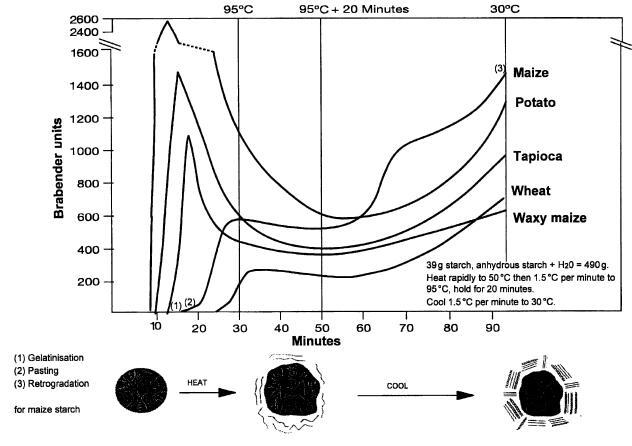
Changes in native starch during processing (From Taggart, 2004 . Reproduced with permission
from woodhead Publishing Ltd., Cambridge, UK).
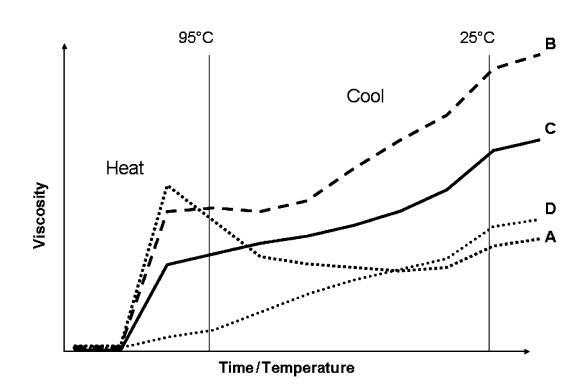
Viscosity curve of modified waxy maize starch at different level of cross-linking
(A: native, B: lightly, C: moderately, D: highly) (starch at 6% concentration in water).
Potato Starch. Potato starches have orthophosphate ester within the potato granule, which tends to weaken bonding and thus lower the energy required for gelatinization (National Starch and Chemical Company, 1996) . In addition, potato starches have relatively large granules, low lipid and protein content, a higher water-binding capacity than other starch types, and yield high paste viscosities. The presence of the esterified phosphate groups stabilizes dispersed phases with high efficiency. Besides water binding, it is sensory characteristics such as texture, appearance, and flavor that have made potato starch successful in meat applications. One major advantage of potato starch is that it will start to gelatinize at the same time as the meat proteins are losing the most water. It is also fully gelatinized between 72°C and 76°C, the same temperature range to which most meat products are cooked. Potato starches are very sensitive in processed meats with a higher salt content.
With the swelling of amylose-containing granules, the amylose molecules are solubilized and leach out into solution. These molecules will then re-associate into aggregates and precipitate at low concentrations or set to a gel at higher starch concentrations. This is referred to as “set back” or retrogradation but can also lead at the same time to a firmer or meatier texture within the final product. This firmness can contribute to better slicing performance.
Waxy Maize Starch. Waxy maize starch has no linear amylose molecules, so its paste will remain flowing. It will not gel or weep and will also give a much softer texture when used in a meat product. Since amylose starch chains tend to retrograde or give up water after packaging, as described above, high-amylopectin starches, like waxy maize, are best suited to achieve long-term water holding capacity.
Tapioca Starch. Having a small amount of amylose, tapioca starch gives a soft gel when pasted. It is used mainly in extremely bland meat systems and also in instances in which a “clean” label declaration is desired. Tapioca starch is generally more expensive than other starches.
To summarize, the amylose content related to the starch variety has an influence on the gelatinization temperature and on the final texture. This must be considered when choosing a starch for use in meat products. Corn starch normally needs to be heated in water to 95°C. Potato starch will absorb more water and the gelatinization temperature is lower, causing the solution to thicken quickly on heating. Tapioca starch gelatinizes at a temperature between that of waxy maize and corn starches, and has a slightly lower viscosity than waxy maize. The gelatinization temperature and the maximum functionality must be achieved during the heat treatment of the final product; otherwise, the starch will not be fully functionalized and its full water-binding capacity and stability will not be reached.
In a study that compared potato starch or potato flour with wheat flour in frankfurters, sensory panels rated the potato starch or flour as providing more tenderness and juiciness (Bushway et al., 1982) . Other trials have confirmed the improved stability and textural firmness of comminuted meat products with added wheat flour and modified corn starch (Comer, Chew, Lovelock, & Allan- Wojtas, 1986) .
Cold Swelling Starches
Cold swelling starches can be used in meat products for several reasons. They work in minced meat products as water binders and texturizers to improve the processability of the uncooked meat. They also help to form the minced meat, keep the water bound in the meat batter, and depending on the kind of starch used, will keep the water bound during processing.
Cold swelling starches can be used as well as suspension aids for insoluble ingredients like cook-up starches. By increasing the viscosity of a brine solution, they can help to avoid sedimentation of these ingredients.
As with cook-up starches, the botanical source of the starch determines the amount of bound water and the final texture. Again, potato starches are widely used due to their high water-binding capacity, where waxy maize starches lead to an improved shelf-life and freeze/thaw stability.
Other Properties of Starch in Meat
Emulsification
In specific products like pâté, where the fat content is high and the fat has a tendency to render out and separate upon cooking, the use of an emulsifying starch is a good option. The emulsifying starch will favor fat stabilization in the meat emulsion. Emulsifying starches are generally not the best water binders, as their primary function is to emulsify. However, they can be combined with viscosifying starches in the same formulation, so as to optimize water binding and control all fluid (fat- and water-based) losses. In some areas, pre-emulsions are prepared, which contain 1 part emulsifier, 5–6 parts fat and 5–6 parts water. These pre-emulsions are used to pre-emulsify fat and enable the use of lower quality fats, up to 20%. They are often stored in coolers for hours or days before use, thereby permitting increased production efficiencies. Protein emulsifiers, very often sodium caseinate or soy protein isolate, can be successfully replaced with an OSA starch or an OSA starch-containing starch composition. But as there is no coldwater- binding, these starch-containing pre-emulsions will be less viscous than those containing protein. However, when using these thinner pre-emulsions, the final result in terms of the quality of the sausage will be comparable.
Fat Mimicry
Fat has a basic effect on various physicochemical (heat transfer, etc.) and sensory (flavor, mouthfeel, juiciness, texture, bite, etc.,) characteristics and it cannot be modified and/or reduced with improper use of fat replacers, less fat, or another type of fat. The food industry has responded to consumer demand by offering an ever-increasing variety of low-fat meat choices. Many good-tasting, low-fat meats are available today, thanks to the growing use of one or more low-calorie fat replacers (Tokusoglu & Ünal, 2003) .
In order to meet the demand for low- or lower-fat meat products, two options are possible: increasing moisture or mimicking fat. Very often fat replacers in the meat industry primarily bind more water, since water replaces fat. By using starches, gums, and proteins, a texture comparable to that of regular fat can be achieved. Combinations of these ingredients can be used to achieve the desired product texture. Starches for this purpose can be used here in a wide range of products, from whole-muscle meats to sausages and bologna. By using functional native starches, more water can be added and retained during the process. This will provide the desired succulence, which disappears when too much lean meat is used. The other possibility is to add starches as fat replacers. One possibility is to add rice starches, as they offer some “fatty behavior,” such as a soft gel structure and a creamy mouthfeel (due to their smooth texture). Rice starch has unique rheological characteristics due to its small particle size, the smallest of all commonly used starches (2–8 μm).
References
Halden , J. P ., Mathiesen , C.-H ., & Proctor , M. S . (1992) . Marinating or pickling of meat. U.S.
Patent No. 5,158,794 . Washington, DC : U.S. Patent and Trademark Office .
Hermansson , A.-M.I . (1979) , Protein/starch complex. U.S. Patent No. 4,159,982 . Washington,
DC : U.S. Patent and Trademark Office.
Hoffman , L. C ., & Mellett , L. D . (2003) Quality characteristics of low lat ostrich patties formulated
with either pork lard or modified corn starch, soya isolate and water . Meat Science , 65 ,
869 – 875.
Institute of Medicine. (2003). Food starch, unmodified. In Food Chemicals Codex (5th ed., pp.
183–184). Washington, DC: National Academies Press.
Jiménez Colmenero , F ., Barreto , G ., Fernández , P ., & Carballo , J . (1996) . Frozen storage of
Bologna sausages as a function of fat content and of levels of added starch and egg white. Meat
Science , 42 , 325 – 332.
Joint FAO/WHO Expert Committee on Food Additives. (2001). Modified Starches. In Combined
compendium of food additive specifications (Food and Nutrition Paper No. 52, addendum 9).
Rome: Food and Agriculture Organization of the United Nations. Retrieved May 24, 2007,
from Food and Agriculture Organization Web Site: http://www.fao.org/ag/agn/jecfa-additives/
specs/monograph3/additive-287.pdf
Joly, G. (n.d.). Unpublished data.
Joly, G (2002). [Evaluation of starch performance in injected and tumbled chicken rolls].
Unpublished data.
You may like
Related articles And Qustion
Lastest Price from Starch manufacturers

US $0.00-0.00/kg2025-07-25
- CAS:
- 9005-25-8
- Min. Order:
- 1kg
- Purity:
- Amylose 70%
- Supply Ability:
- 20MT
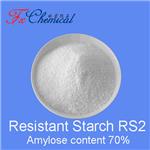
US $5.00-4.00/kg2025-04-21
- CAS:
- Min. Order:
- 1000kg
- Purity:
- Amylose 70%
- Supply Ability:
- 500000kg

